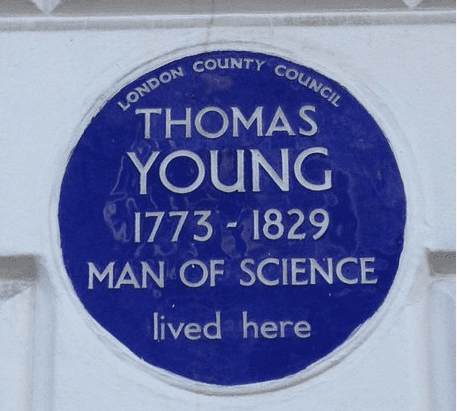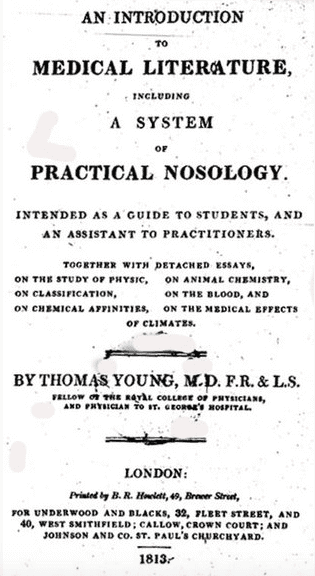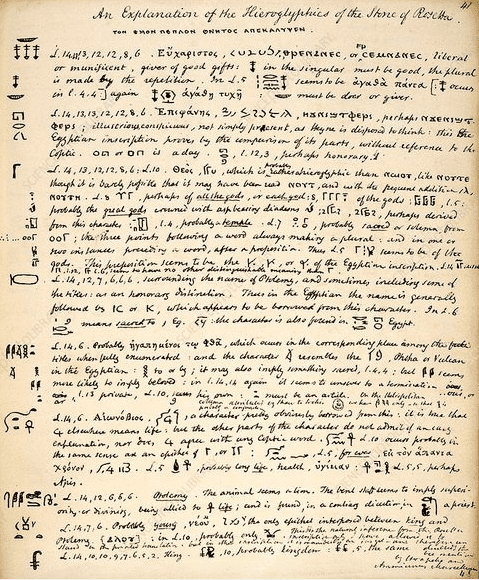JMS Pearce
East Yorks, UK
 |
| Fig 1. Thomas Young. Mezzotint by G. R. Ward, 1855, after Sir T. Lawrence. Credit: Wellcome Collection. Attribution 4.0 International (CC BY 4.0) |
It is impossible to place precisely Thomas Young (Fig 1) into any professional class. He was both physician and scientist, renowned for an astonishing range of theories and discoveries in optics, physics, physiology, hieroglyphics, and medicine. His sundry contributions were profound, original, and ingenious; he has with good reason been likened to Leonardo da Vinci. Only fragments of his personal life have survived since many of his letters, journals, and papers were anonymous or have disappeared.
Thomas Young was the eldest of ten children of a Quaker family living in Milverton in Somerset. His father Thomas was a cloth merchant, his mother was Sarah Davis. Both were “stiff Quakers” towards whom he felt little warmth,1 having spent much of his lonely childhood with his maternal grandfather in Minehead. The family moved in 1782 to Compton Abbas in Dorset, where his schooling was more progressive. On leaving at aged only fourteen, he became the tutor and companion to Hudson Gurney, the grandson of the Quaker banker David Barclay in Hertfordshire.
Young said he owed his powers of determination and perseverance to the Society of Friends—influences that can be seen in his development, though its practices he later set aside.2 According to Crichton-Browne,3 the unusually isolated nature of his youth may account for some of his unsympathetic style and rigidity.
Medical contributions
He began to study medicine in London at St. Bartholomew’s hospital in 1793, and was taught by John Hunter, William C Cruikshank, James Edward Smith, and Matthew Baillie. He moved in 1794 to Edinburgh, where he was taught by Alexander Monro (secundus) and Joseph Black. A year later he obtained a Doctorate in Physic in Göttingen (1796), but as an all-rounder also pursued history and natural philosophy, drawing, riding, dancing, and playing the clavichord. In 1797 he entered Emmanuel College, Cambridge, where his brilliant polymathy caused him to be known as “Phenomenon Young.” He graduated MB Cantab in 1803 then MD five years later.
While still in medical school, curious to discover the mechanism of accommodation, he observed that an ox eye changed shape when focusing on near and distant objects. Shortly afterwards, a Memoir on the structure of the Lens was contributed to the Royal Society in May 1793, when he was aged only twenty, and was followed by his election as FRS the next year. Young also showed that the mechanism of astigmatism was a difference in degree of curvature of the two different meridians (i.e., the eye’s different focal points in different planes) arising in the lens or cornea.4
 |
| Fig 2. Thomas Young, Blue plaque at 48, Welbeck St, London. Photo by Gareth E Kegg. Via Wikimedia. CC BY-SA 4.0. |
A substantial inheritance from his mother’s uncle, Dr. Brocklesby, made him financially independent, and by 1799 he had established himself as a physician at Welbeck Street, London (now recorded with a blue plaque)(Fig 2). His Croonian lecture for 1808 was entitled Functions of the Heart and Arteries and was a closely reasoned physiological appraisal and mathematical investigation of the circulation, “hydraulics,” muscular and elastic powers of the heart and arteries.
He was appointed Physician to St. George’s Hospital, London, in 1811. His medical writings included an astonishingly detailed, critical, and referenced Linnaean type classification of diseases, An Introduction to Medical Literature, including a System of Practical Nosology (1813) (Fig 3), and A Practical and Historical Treatise on Consumptive Diseases (1815).5 He invented a simple rule to determine the correct dose of drugs for children, known as Young’s rule: a child’s dosage equals the adult dosage multiplied by the child’s age in years, divided by the sum of twelve plus the child’s age.
Medical practice remained the focus of his professional life and he attained much respect, but he sometimes confessed disappointment2(p.74) since he was less popular than some other contemporary doctors. His biographer Peacock noted that with patients he “was gentle, gentlemanly but not genial.” Likewise, Sir Benjamin Brodie observed: “He was too good at his profession and above certain ignoble arts . . . made use of by competitors.” Perhaps this fits with the scrupulous objectivity of the scientist and the conservative reserve derived from his Quaker roots.
 |
| Fig 3. Young’s An Introduction to Medical Literature, including a System of Practical Nosology (1813) |
Wave Theory of light, Young’s fringes, Young’s modulus
Young made notable scientific contributions to the fields of vision, light, solid mechanics, energy, physiology, language, musical harmony, and Egyptology. In 1801, using an analogy with sound waves, Young studied optical interference, observing that when a single light source is split into two beams, they are recombined by a lens to produce a pattern of light and dark fringes: “I have found so simple and so demonstrative a proof of the general law of the interference of two portions of light . . .” These fringes he cleverly deduced were caused by the beams of light behaving as waves with peaks and troughs. It “showed that light added to light could produce more light—or, most surprisingly, darkness.” He expounded his theory in the Bakerian lectures for 1800, 1801, and 1803.6 The interference pattern (Young’s fringes) could only be explained by an undulatory or wave theory shown as alternating bands of light and dark; this led to the Young-Fresnel undulatory theory that disproved Newton’s idea that light consisted of a flow of particles. It also explained “all the phenomena of the colors of thin plates” (such as Newton’s rings). His first paper on Wave Theory led to his appointment as Professor of Natural Philosophy at the Royal Institution on 20 January 1801. Nonetheless, at first many scientists, notably Henry (later Lord) Brougham, unfairly and anonymously rejected his opinions.
By 17 May he had delivered no less than thirty-one lectures, and by the end of 1802 he had given sixty, which were published four years later as A Course of Lectures on Natural Philosophy and the Mechanical Arts. This was one of the “sacred” books of Physical Science; its expositions have never been excelled.3
He then applied his new Wave Theory to explain the colors of thin films of soap bubbles. By relating color to wavelength, he calculated the wavelengths of the seven colors recognized by Newton. Since these theories differed from those of Hermann von Helmholtz (1821–1894),a inventor of the ophthalmoscope, he suggested three different sets of nerve cells or cones in the retina, each sensitive to a primary color: red, blue, or green. This became known as the Young-Helmholtz trichromatic theory. The modern understanding of optics and eye diseases rests heavily on these discoveries.
Young’s varied experiments in physics7 were outstanding in their originality; they quickly achieved general acceptance. He observed in 1804 the constancy of the angle of contact of a liquid surface with a solid, from which he deduced the phenomena of capillary action.
Young proposed a constant in the mathematical equation that described elasticity, known as Young’s modulus. He also produced the first correct and comprehensive arch theory still used in the construction of bridges.
Not only skilled in sciences, Young wrote lucidly on many topics published in the Gentleman’s Magazine, the British Magazine, the Journal of the Royal Institution,8 the Quarterly Review, and the Nautical Almanac (which he edited from 1818). He contributed over sixty anonymous articles and biographies to a supplement of the Encyclopaedia Britannica—listed in the renowned antiquarian and bibliophile Hudson Gurney’s Memoir of the Life of Thomas Young (1831).
 |
| Fig 4. Young’s notes on translation of the Rosetta Stone |
Rosetta stone
From his youth the versatile Young taught himself mathematics, Greek, Latin, and Hebrew, as well as French and Italian. His passion for eastern languages subsumed Arabic, Persian, Chaldee, Syriac, and Sumerian, later evident in his Encyclopædia Britannica article “Languages.”
He examined ancient hieroglyphics, enabling him to study Egyptology. In 1814 this led him to examine the Rosetta Stone, discovered at Rashid (Rosetta) in 1799. The stone was an igneous stele containing three versions of a decree written in ancient hieroglyphs (suitable for a priestly decree), Demotic (the Egyptian language of the people), and Ancient Greek of the Greco-Macedonian administrators.9 This decree was issued in 196 BC on the anniversary of King Ptolemy V. After investigating other hieroglyphic writings, Young deciphered the second Egyptian script on the stone, known as demotic, (Fig 4) descried in a long article, “Egypt,” which he later contributed to the Encyclopædia Britannica. Jean-François Champollion subsequently constructed an alphabet of phonetic hieroglyphic characters. Young’s early study created the conceptual framework that made possible Champollion’s later works. The stone eventually came to the British Museum in 1802.
He was adviser to the Admiralty on shipbuilding, secretary of the Board of Longitude, and for a decade superintendent of the vital Nautical Almanac. He contributed many entries to the Encyclopaedia Britannica (1816-1825). Young was also Physician to and inspector of calculations for the Palladian Insurance Company. William Herschel, Hermann von Helmholtz, Sir Joseph Banks, James Clerk Maxwell, and Albert Einstein each praised him.
So why is Thomas Young not better known? One reason is that after Henry Brougham had without evidence excoriated his wave theory, in order to protect his reputation, he chose to write many scientific (but not medical) articles anonymously, believing “it will do better without my name on it.” Furthermore, his lectures, though excellent in content, were so condensed that many failed to understand his arguments. His spoken explanations of his theories were often abstruse and laconic to the point of obscurity. In his later lifestyle he gradually abandoned several Quaker traditions, but with few friends he remained conservative, self-effacing, and unwilling to display his own profound knowledge. Indeed his Cambridge tutor once remarked that he seldom gave an opinion, and never volunteered one. He never laid down the law like other learned doctors.
In 1804 he married Eliza Maxwell, with whom he enjoyed a gracious refined home within a happy marriage, but had no children. Young died aged 56 in London on 10 May 1829, having suffered from breathlessness, hemoptysis, and weakness. His autopsy (performed by Benjamin Brodie) showed ossification of the whole aorta and left ventricular hypertrophy. He was buried at St. Giles Church, Farnborough in Kent. Westminster Abbey houses a white marble tablet in his memory, bearing an epitaph by Hudson Gurney: a man alike eminent in almost every department of human learning. His contemporary, the astronomer Sir John Herschel called him a truly original genius.
Notes
- Helmholtz’s mother was a lineal descendant of the Quaker William Penn whose family founded Pennsylvania. He wrote in 1847 one of the great scientific papers of the 19th century: Über die Erhaltung der Kraft [On the conservation of energy].
References
- Robinson, Andrew. The Last Man Who Knew Everything: Thomas Young, the Anonymous Polymath Who Proved Newton Wrong, Explained How We See, Cured the Sick and Deciphered the Rosetta Stone Among Other Feats of Genius. New York: Pi Press 2006.
- Wood A. Oldham F. Thomas Young natural philosopher, 1773–1829. Cambridge University Press, 1954.
- Crichton Browne J. Thomas Young. In: Stray leaves from a physician’s portfolio. No Date, [probably 1927]. Hodder & Stoughton. First edn pp.298-328.
- Land M. Focusing by shape change in the lens of the eye: a commentary on Young (1801) ‘On the mechanism of the eye’. Phil. Trans. R. Soc. 1015; B 370: 20140308.
- Young T. A Practical and Historical Treatise on Consumptive Diseases. London, Underwood 1815.
- Young Thomas. The Bakerian Lecture. Experiments and Calculations relative to physical Optics. Philosophical Transactions of the Royal Society, 94, 1 (January 1, 1804),
- Peacock G. Life of Thomas Young, M.D., F.R.S., &c. London. J Murray 1855. https://archive.org/stream/lifethomasyoung01peacgoog/lifethomasyoung01peacgoog_djvu.txt
- Cantor G N. ‘Thomas Young’s lectures at the Royal Institution’, Notes and Records of the Royal Society, 1970;25: 87–112 9
- Wallis Budge EA. Translation of the Rosetta stone. From the Nile, notes for travellers in Egypt, 9th edition, London, Thos. Cook and son, [1905], pp. 199-211.
JMS PEARCE, MD, FRCP, is a retired neurologist and author with a particular interest in the history of science and medicine.
Fall 2020 | Sections | Physicians of Note

Leave a Reply